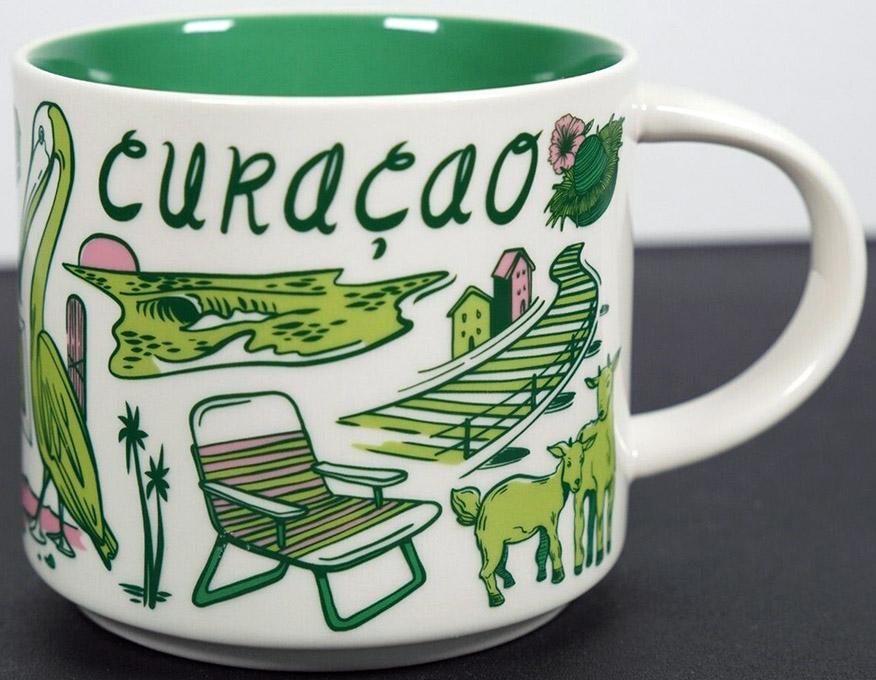
Been There – Curacao
Starbucks Been There – Curaçao mug was initially spotted in personal collections back in 2019, however it was never seen in stores till recently. Not sure what was the reason for the delay, but here it is, brand new and nice looking.
Curaçao, a constituent country of the Kingdom of the Netherlands, lies in the southern Caribbean Sea, about 65 kilometers north of the Venezuelan coast. Its capital and largest city, Willemstad, is renowned for its colorful Dutch colonial architecture, earning it recognition as a UNESCO World Heritage Site. With a population of around 160,000 people, Curaçao boasts a diverse culture influenced by African, European, and indigenous Caribbean traditions. Historically, the island was inhabited by the Arawak people before being colonized by the Spanish in the early 16th century. In 1634, the Dutch took control of Curaçao, establishing it as a center for trade and commerce in the region. The island played a significant role in the Atlantic slave trade, with its natural harbor serving as a major hub for the transport of enslaved Africans to the Americas. After the abolition of slavery in 1863, Curaçao’s economy diversified, and it eventually gained autonomy within the Kingdom of the Netherlands in 1954.
Did you know that the most widely spoken language in Curacao is Papiamento? It is a creole language spoken primarily in the Dutch Caribbean islands of Aruba, Bonaire, and Curaçao. Papiamento is a unique blend of Portuguese, Spanish, Dutch, African, and indigenous languages, reflecting the diverse cultural heritage of the region. With its melodic cadence and expressive vocabulary, Papiamento serves as a symbol of cultural identity and unity among the people of the Dutch Caribbean.
Here are some points of interest in Curacao, that the designers of the mug suggest to visit:
As I’ve mentioned above, the capital city of Willemstad boasts vibrant Dutch colonial architecture, especially along the picturesque Handelskade waterfront, providing a delightful backdrop for exploration and photography.
Also known as the “Swinging Old Lady”, the Queen Emma Bridge is a floating pontoon bridge in Willemstad, offering both a practical pedestrian crossing and a unique attraction as it swings open to allow ships to pass through St. Anna Bay.
The Queen Juliana Bridge is a four-lane road bridge that crosses St. Anna Bay too. It is the highest bridge in the entire Caribbean, reaching a height of 185 feet above the water at its apex. The bridge was opened on Queen’s Day, April 30, 1974, and is named after Queen Juliana of the Netherlands. It was constructed to allow automobile traffic to cross from Punda to Otrobanda, replacing the Queen Emma Bridge for vehicular traffic. The view from the bridge offers a panoramic vista of Punda, Otrobanda, and the Schottegat, making it one of the highest vantage points on the island.
Curaçao is home to significant historical sites such as Fort Amsterdam, the oldest fort in the Caribbean, which stands as a testament to the island’s colonial past, and the Kura Hulanda Museum, which vividly portrays the island’s African heritage and the history of slavery.
Symbolizing the island’s culinary heritage, the Curacao Liqueur Distillery produces the famous blue liqueur made from the laraha citrus fruit, offering tours and tastings to visitors interested in learning about the island’s distilling traditions.
The impressive Hato Caves are a popular attraction in Curacao. These caves feature stunning limestone formations and offer guided tours that provide insights into the island’s geological history.
Dive into the underwater world of Curaçao at the Curaçao Sea Aquarium, where visitors can marvel at colorful coral reefs, encounter a variety of marine life, and even participate in interactive experiences like swimming with dolphins.
Nature enthusiasts can explore Christoffel National Park, where they can hike Mount Christoffel, the highest peak on the island, offering stunning views of the surrounding landscape and opportunities to encounter native flora and fauna.








































































